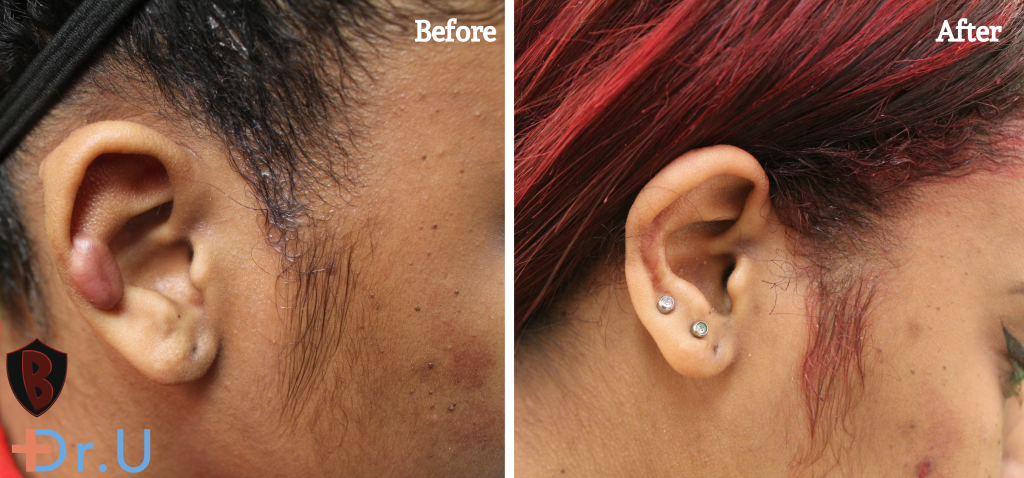So, you have keloid-prone skin and want to get a tattoo. It can feel frustrating not knowing if it’s worth the gamble or if you should play it safe. Understanding what makes someone prone to keloids, assessing all the risks, and learning how to prevent and manage keloids may be helpful in coming to a decision.
What Makes Someone Prone To Keloids?
While the exact cause of keloids is not fully understood, several factors may contribute to their development, including genetics, ethnicity, skin color, and the location of the wound. Additionally, certain medical conditions, such as acne and chickenpox, and certain surgeries may also increase the likelihood of developing keloids. Vaccination sites are also prime locations for keloids if you have keloid-prone skin. Finally, evidence suggests that a person’s age, immune system, and hormonal balance also play a role.

Should You Get That Tattoo?
Keloids can occur with tattoos or piercings, but they are uncommon. Studies estimate that keloids develop in 5-10% of people who receive tattoos and up to 30% of people who get piercings. However, keloids are more likely to develop in people who have a family history of them or who have dark skin. If you are worried about keloids, talk to your dermatologist to assess the risks, and talk to the tattoo artist about the best ways to prevent them.
Tattooing Over A Keloid Scar
Tattooing over a keloid scar can be risky, as the scar tissue may not hold the ink well and may cause the tattoo to appear blurry or uneven. It’s best to consult a professional tattoo artist with experience working with keloid scars to determine if tattooing over the scar is safe and feasible. Additionally, it’s always a good idea to consult a dermatologist before investing in a tattoo over a keloid scar.
Your Tattoo Triggered a Keloid Growth. Now What?
One recommended treatment for keloids is steroid injections, which can help to reduce inflammation and promote healing. Other options include cryotherapy, laser therapy, and radiation therapy. It’s essential to consult a dermatologist to determine the best treatment for your particular situation, especially because keloids tend to return after removal – often, more invasively.
Surgical keloid removal is the most effective way, especially for bigger scar tissues. It is vital to have the procedure performed by a qualified and experienced physician to ensure the best possible outcome. Try to find a specialist with a track record of permanently removing keloids.
Dr. U., AKA The Bumpinator
Regarding keloids, Dr. Bumpinator, AKA Dr. Umar, is one of the most qualified surgeons. As a pioneer in scar and skin bump removal, he has developed advanced surgical techniques to masterfully rid his patients of dreadful bumps.
The removal of the keloids is only part of the job. For many patients coming in, Dr. Bumpinator is not the first dermatologist they visit. Keloid scars are known for frequently returning post-removal. This is because keloid-prone skin overproduces collagen to repair itself post-trauma. A surgical incision is also registered as trauma, so if you’re prone to developing raised scars, it shouldn’t come as a surprise if you start seeing new growth at the surgery site.
This is why seeing a doctor who deals with keloids is especially critical. Dr. Bumpinator strives for long-lasting results post-removal. Read about how this young man had a keloid for almost 20 years and had gotten it removed and treated five times before coming to Dr. Umar. Each time, his keloid would return bigger. Dr. Umar’s goal was to make the patient’s sixth time his last.
FAQ
I got a tattoo a month ago, and no keloids so far. Am I in the clear?
It’s hard to tell because keloids can take months to start developing after trauma. If you have keloid-prone skin, continue monitoring the area to catch it earlier if you develop a keloid.
I have a keloid at the site of my piercing. Does this mean a tattoo will also cause a keloid?
Although there is no sure way of predicting whether a tattoo would trigger keloid growth, the fact that you already have a keloid indicates that your skin tends to it. A tattoo is a minor skin trauma than a piercing, especially if you’re not getting a big piece. There is a good chance you’re safe to get a tattoo, but theoretically, you’re at risk.
References
- Keloid Scar. Mayo Clinic. https://www.mayoclinic.org/diseases-conditions/keloid-scar/symptoms-causes/syc-20520901#:~:text=Keloid%20growth%20might%20be%20triggered,aren’t%20contagious%20or%20cancerous. Published October 11, 2022. Accessed March 27, 2023.
- Keloid scars: Overview. American Academy of Dermatology. https://www.aad.org/public/diseases/a-z/keloids-overview#:~:text=Researchers%20have%20found%20that%20between,have%20a%20darker%20skin%20tone. Accessed March 27, 2023.
- Keloids. Pennmedicine.org. https://www.pennmedicine.org/for-patients-and-visitors/patient-information/conditions-treated-a-to-z/keloids. Accessed March 27, 2023.